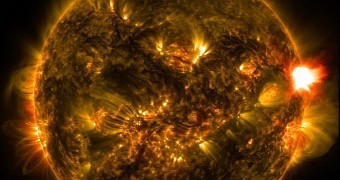Just days ago, on January 12, our Sun threw a fit and produced a massive sudden burst of high-energy radiation. The event, known to scientists as a solar flare, was documented with the help of NASA's Solar Dynamics Observatory.
The thing about solar flares is that, although they occur on the surface of the Sun, which sits at a distance of nearly 150 million kilometers (about 93 million miles) from our planet, they can still mess with our daily routine.
More precisely, scientists say that such bursts of radiation have the potential to upset our atmosphere's upper layer, and in doing so, they affect GPS and communication signals. Hence, it would be really cool if we could anticipate such an event.
The problem is that, despite the fact that they have been studying them for decades now, researchers are yet to pin down the mechanisms that cause solar flares to occur. Consequently, they can't say when they are likely to happen.
Using artificial intelligence to predict solar flares
In an attempt to tackle this problem and find a solution to it, Stanford University solar physicists Monica Bobra and Sebastien Couvidat turned their attention to artificial intelligence techniques.
Their goal was to develop a method to automate the analysis of these sudden releases on high-energy radiation and pave the way towards the development of a warning system especially coined to serve and protect power grids and communication satellites.
“Machine learning is a sophisticated way to analyze a ton of data and classify it into different groups,” scientist Monica Bobra explained the decision to turn to artificial intelligence in an attempt to predict potentially dangerous solar flares.
What this research project boiled down to
As part of their work, the scientists fed data obtained by NASA's Solar Dynamics Observatory to a machine learning software. This data concerned as many as 25 distinct features of roughly 2,000 active regions on the surface of the Sun.
Of the data that the researchers had at their disposal, just 70% was fed into the learning machine and served to establish patterns of solar activity. The remaining 30% was used to test the accuracy of the patterns identified.
Thus, what the scientists essentially did was to develop a machine learning software able to predict how strong one solar flare or another would be, based on information concerning the distinctive features of sunspots.
“Machine learning confirmed that the topology of the magnetic field and the energy stored in the magnetic field are very relevant to predicting solar flares,” Monica Bobra and Sebastien Couvidat explain in a statement.
“Using just a few of the 25 features, machine learning discriminated between active regions that would flare and those that would not flare,” the Stanford University solar physicists go on to detail their work.
Seeing how the Sun's atmosphere influences the behavior of solar flares, the scientists say that, in the future, they plan to incorporate information concerning its makeup and behavior into their solar flare-predicting machine learning software.
It really isn't as complicated as it might sound
Just to put things into perspective, the solar physicists explain that what they did is not all that different to using machine learning software to predict which individuals are likely to be better swimmers, based on bits and pieces of information about them.
The idea is that the machine learning can teach itself information such as the name of a swimmer's dog is of no relevance, whereas their height or weight most definitely influences their performance.
Just like when it comes to predicting the strength of solar flares, a machine learning software works best when fed plenty of information to begin with. Thus, the more initial data it has at its disposal, the easier it is for it to identify patterns.

 14 DAY TRIAL //
14 DAY TRIAL //